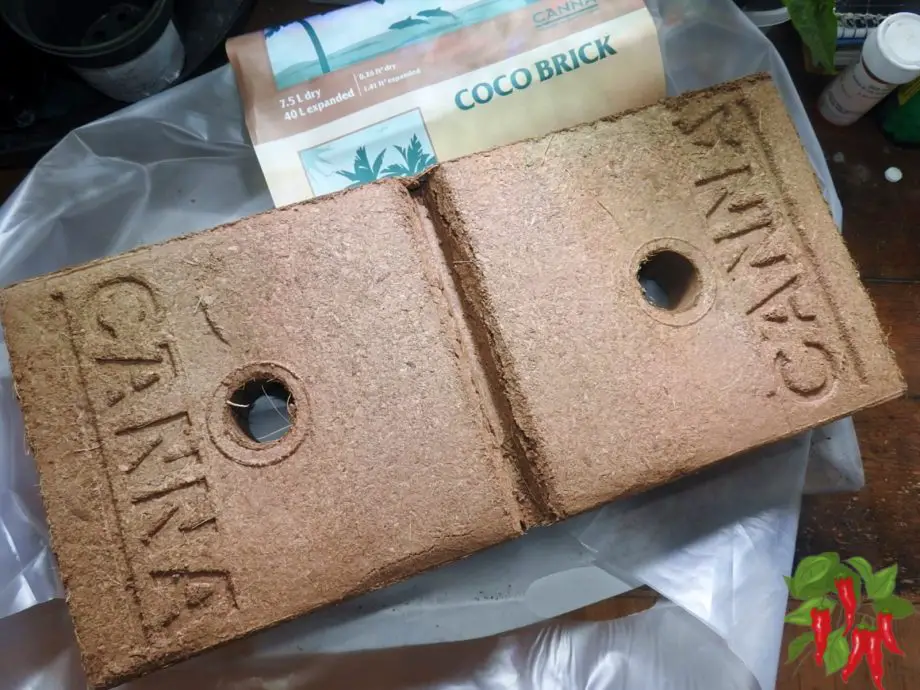This post may contain affiliate links. If you buy something from one of our links we may earn a commission. Thanks
Discover how to use coco coir bricks in gardening! Our friendly guide makes it simple and fun to master this sustainable method.
Using Coco Coir Bricks Key Takeaways:
- Using Coco Coir Bricks is straightforward.
- Simply soak the brick in about 3 gallons of water to expand it into usable coir.
- This process softens the coir, making it ready for planting.
- Remember to add nutrients, as Coco Coir is low in essential elements like calcium and magnesium.
Here is my video showing how to use coco coir bricks:
How To Use Coco Coir Bricks: A Step-by-Step Guide for Gardeners
Ever wondered how to use coco coir bricks for your plants? You’re in the right place!
Let’s dive into the world of Coco Coir, a fantastic, sustainable medium that’s transforming indoor and container gardening.
Join us as we explore this easy, effective method to enhance your green thumb!
Start With The Right Coco Coir

Welcome to our comprehensive guide on using Coco Coir Bricks! As a versatile and sustainable medium, Coco Coir has gained popularity among gardeners.
In this post, we’ll walk you through the process of rehydrating and using Coco Coir bricks, sharing tips and tricks to make the most of this fantastic gardening resource.
There are many brands of coco and not all are suitable for growing plants. Coconut palms grow by the ocean and absorb a lot of salt.
This must be leached out before the coco is suitable for plants. Coco is often used for bedding and is not leached.
I recommend using Canna Coco Coir. It is prebuffered and low in salt and has great texture.
Canna actually introduced coco to Dutch farmers and then the world. It is still the best. It’s what I use.
Understanding Coco Coir Bricks:
Coco Coir bricks are a convenient and eco-friendly option for gardeners.
They are made from compressed coconut fiber, offering an alternative to traditional potting mixes.
These bricks are dry, compact, and easy to store, making them an ideal choice for indoor gardening.
When you purchase Coco Coir in brick form, you’re getting a product free from pests like fungus gnats, a common issue with loose Coco Coir.
Using bricks also ensures that you’re starting with a clean, sterile medium, essential for healthy plant growth.
Using Coco Coir Bricks Step By Step
Step 1: Preparing Your Workspace:
Begin by setting up a suitable area for rehydrating your Coco Coir brick.
You can use a large tote or a similar container to accommodate the expansion of the coir.
I use a 14-gallon tote, it’s perfect for the task. Place the Coco Coir brick inside the tote.
If desired, you can break the brick in half to speed up the rehydration process. This step is optional but can be helpful, especially if you’re in a hurry or dealing with larger bricks.
Step 2: Rehydrating the Coco Coir Brick:
Rehydrating the brick is a crucial step. You’ll need about 3 gallons of water for one brick, which typically expands to about 5 gallons of usable Coco Coir.
I add my Cal/Mag to this water at 3 ml per gallon so I use about 10 ml of CaliMagic. I find this to be the best.
Pour the water over the brick in the tote. The coir will slowly start to absorb the water and expand.
This process can take up to 30 minutes, so patience is key. During this time, the Coco Coir will transform from a hard, compressed brick to a soft, pliable growing medium.
It’s fascinating to watch the brick expand and change texture, illustrating the incredible absorption capacity of Coco Coir.
Step 3: Adding Nutrients (Calcium and Magnesium):
Coco Coir is naturally low in nutrients, so it’s essential to supplement it.
One critical aspect of using Coco Coir is its cation exchange capacity, which refers to the medium’s ability to hold and release certain nutrients. Coco Coir tends to hold onto potassium at the expense of calcium and magnesium.
To counter this, add a calcium and magnesium supplement to the water before rehydrating the coir.
A good ratio is about 3 milliliters of a calcium-magnesium supplement (like General Hydroponics CaliMagic) per gallon of water. This addition ensures that your plants will have access to these essential nutrients.
Step 4: Expanding and Using the Coco Coir:
As the Coco Coir absorbs water, it will start to expand. You’ll notice it becoming softer and more pliable.
Once fully expanded, the Coco Coir is ready to use. It’s now a fluffy, airy medium, perfect for planting.
If you’re using Coco Coir for the first time, you’ll appreciate its texture and how it promotes healthy root growth.
It’s also worth noting that while there’s an extra step involved in preparing Coco Coir compared to other mediums, the benefits far outweigh the initial effort.
The lack of pests, ease of storage, and the sustainability aspect make Coco Coir a top choice for many gardeners.
Step 5: Filling Planters and Growing:
With your Coco Coir ready, you can begin filling your planters. Whether you’re using traditional pots, stackable planters, or any other type of container, Coco Coir is an excellent medium.
It’s particularly well-suited for container gardening due to its excellent water retention and aeration properties.
Fill your planters to the desired level, ensuring the coir is evenly distributed.
Once your planters are filled, you’re ready to plant. Coco Coir is versatile and can support a wide range of plants, from vegetables to ornamentals.
Remember to monitor the moisture levels and nutrient content, as Coco Coir requires regular feeding due to its low nutrient content.
FAQs: Using Coco Coir Bricks
In this section, we address some frequently asked questions about using Coco Coir bricks.
Whether you’re a seasoned gardener or new to the world of Coco Coir, these answers will help clarify common queries and provide valuable insights into making the most of this versatile medium.
Q: How much water do you put in coco coir bricks?
A: For rehydrating a standard Coco Coir brick, use approximately 3 gallons of water.
This amount is generally enough to expand the brick into about 5 gallons of usable Coco Coir. The exact amount may vary slightly depending on the size of the brick.
Q: How do you soften coco coir bricks?
A: To soften Coco Coir bricks, soak them in water. Place the brick in a large container and pour the required amount of water over it.
Allow the brick to sit in the water for up to 30 minutes, during which it will absorb the water and become soft and pliable.
Q: How do you break up coco coir bricks?
A: You can break up Coco Coir bricks by first soaking them in water until they expand and soften.
Once soft, you can easily crumble the coir with your hands or a tool like a garden fork to break it up into a usable medium.
Q: Do you need to add anything to coco coir?
A: Yes, since Coco Coir is naturally low in nutrients, it’s beneficial to add a calcium and magnesium supplement to the water before rehydration.
This supplementation helps balance the cation exchange capacity of the Coco Coir, ensuring better nutrient availability for plants.
Q: Is there any disadvantage to using coco coir?
A: The primary disadvantage of using Coco Coir is its low nutrient content, requiring regular supplementation.
Additionally, the need to rehydrate and possibly buffer the coir adds extra steps compared to some other mediums.
Q: What happens if you don’t buffer coco coir?
A: If you don’t buffer Coco Coir, it may hold onto potassium at the expense of calcium and magnesium, leading to nutrient imbalances.
This can affect plant growth and health. Buffering helps ensure a more balanced nutrient profile in the coir.
Q: Do I need to add perlite to coco coir?
A: Adding perlite to Coco Coir can improve drainage and aeration, which is beneficial for root health. The amount of perlite you add can vary depending on your plants’ needs but typically ranges from 10% to 30% of the total volume.
Q: Should you water coco coir every day?
A: The frequency of watering Coco Coir depends on various factors like plant type, container size, and environmental conditions.
Coco Coir retains moisture well, so daily watering may not be necessary. However for best results dont let coco coir dry out.
Monitor the moisture level and adjust your watering schedule accordingly.
Q: Why use coco coir instead of soil?
A: Coco Coir is preferred over soil for several reasons: it’s more sustainable, has excellent water retention and drainage properties, is pest-free, and provides a sterile medium for plant growth.
Additionally, its lightweight nature makes it ideal for indoor and container gardening.
Using Coco Coir Bricks: Conclusion
In conclusion, using Coco Coir bricks is a simple and effective way to enhance your gardening experience.
Its sustainability, ease of use, and pest-free nature make it a superior choice for indoor and container gardening.
If you’re considering using Coco Coir, we highly recommend giving it a try.
You’ll find it a rewarding addition to your gardening toolkit. Happy gardening!
Read more: Indoor Apartment Gardening: 15 Point Comprehensive Guide
Visit my Amazon Influencer Page for videos and gardening products Grow Your Own Garden








